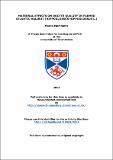Files in this item
Maternal effects on oocyte quality in farmed Atlantic halibut (Hippoglossus hippoglossus L.)
Item metadata
| dc.contributor.advisor | Johnston, Ian A. | |
| dc.contributor.advisor | Babiak, Igor | |
| dc.contributor.advisor | Fernandes, Jorge M. O. | |
| dc.contributor.author | Mommens, Maren | |
| dc.coverage.spatial | 267 | en_US |
| dc.date.accessioned | 2013-06-11T08:28:11Z | |
| dc.date.available | 2013-06-11T08:28:11Z | |
| dc.date.issued | 2012 | |
| dc.identifier | uk.bl.ethos.574773 | |
| dc.identifier.uri | https://hdl.handle.net/10023/3661 | |
| dc.description.abstract | Atlantic halibut (Hippoglossus hippoglossus) oocyte quality is highly variable and one of the major bottlenecks during fry-production for on-growth in commercial Atlantic halibut farming. In this study, the effect of maternally derived oocyte constituents (i.e. yolk components and mRNAs) on oocyte quality (i.e fertilisation, embryonic hatching and normal blastomere symmetry) in farmed Atlantic halibut has been investigated. Atlantic halibut embryos and larvae depend on nutritional yolk components until larval first feeding. The importance of yolk n-3 fatty acids for oocyte quality was confirmed. However, highest positive correlations with oocyte quality were found for the less studied fatty acids dihomo-γ-linolenic acid (DGLA, 20:3n6) and docosapentaenoic acid (DHA, 20:5n3) that are known to compete with two of the most abundant fatty acids, arachidonic acid (ARA, 20:4n6)and docosahexaenoic acid (DPA, 22:5n3), respectively during fatty acid metabolism. High methionine and aspartic concentrations, amino acids essential to eukaryotic protein synthesis, were found to influence oocyte quality positively while no significant correlations were found between oocyte folate concentrations and oocyte quality. Before activation of zygotic transcription, maternal mRNAs control cell divisions and embryonic patterning. Due to the limited available genomic information on Atlantic halibut maternal transcripts, an expressed sequence tag (EST) maternal library containing 2,341high quality ESTs was created by suppressive subtractive hybridization (SSH). The maternal library constitutes an EST pool to identify suitable Atlantic halibut reference genes and identify differentially expressed maternal genes in high and low quality Atlantic halibut oocytes. To perform reliable quantification of gene expression by qPCR, stable reference genes have to be used to normalize target gene expression. Tubb2/Actb and Tbb2/Fau were identified as the best two-gene normalization factors during Atlantic halibut embryonic and larval development. Either of these normalization factors can be used for future developmental gene expression studies in Atlantic halibut. Tubb2/Actb was further used as reference gene during this study. Poor embryonic hatching success was found to not be correlated with a general decrease in oocyte maternal transcript abundance but with low transcript levels of specific maternal transcripts by qPCR. The majority of genes showed either no or very minor correlations between their transcript levels and oocyte quality parameters (Fertilisation: 13-93 %, embryonic hatching: 1-94 %). However, maternal transcript levels of three genes, most likely involved in nuclear protein and mRNA transport, growth factor regulation, and embryonic patterning, correlated with oocyte quality. Further, a new Atlantic halibut 4x44k oligonucleotide microarray was constructed and used to identify 192 strictly maternal genes during Atlantic halibut embryonic development and 20 differentially expressed genes between high and low quality oocytes, involved in immune response, metabolism, RNA transcription, protein degradation, cell signalling and the cytoskeleton. Microarray validation confirmed its suitability for future gene expression studies during Atlantic halibut embryonic development. The identified maternal genes in this study can serve as a pool for future in-depth studies of embryonic gene expression to advance the knowledge of important developmental processes such as germ cell development, growth and immune response in Atlantic halibut. Some of these may serve as possible markers for Atlantic halibut oocyte quality due to their high expression differences between high and low quality oocytes. Future nutritional studies on Atlantic halibut broodstock should focus on the identified yolk constituents acting positively on oocyte quality. | en_US |
| dc.language.iso | en | en_US |
| dc.publisher | University of St Andrews | |
| dc.subject.lcc | QL638.P7M7 | |
| dc.subject.lcsh | Atlantic halibut--Embryology | en_US |
| dc.subject.lcsh | Atlantic halibut--Genome mapping | en_US |
| dc.subject.lcsh | Atlantic halibut--Spawning | en_US |
| dc.title | Maternal effects on oocyte quality in farmed Atlantic halibut (Hippoglossus hippoglossus L.) | en_US |
| dc.type | Thesis | en_US |
| dc.type.qualificationlevel | Doctoral | en_US |
| dc.type.qualificationname | PhD Doctor of Philosophy | en_US |
| dc.publisher.institution | The University of St Andrews | en_US |
This item appears in the following Collection(s)
Items in the St Andrews Research Repository are protected by copyright, with all rights reserved, unless otherwise indicated.

